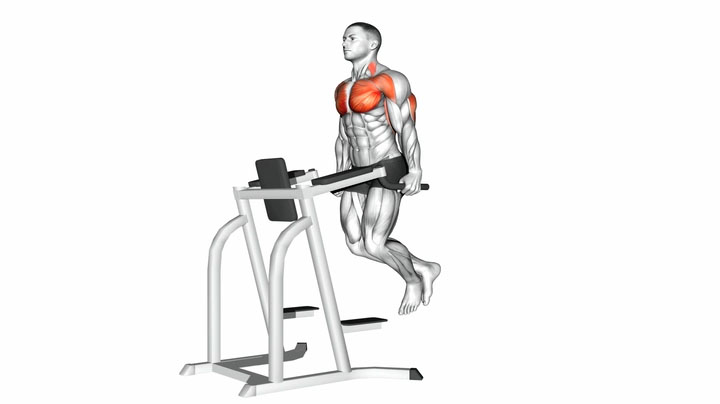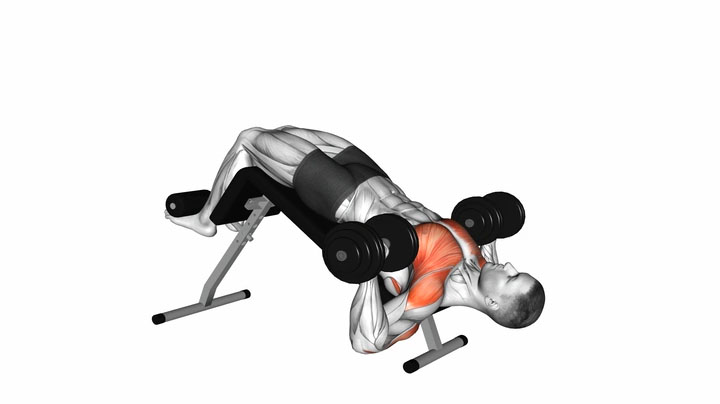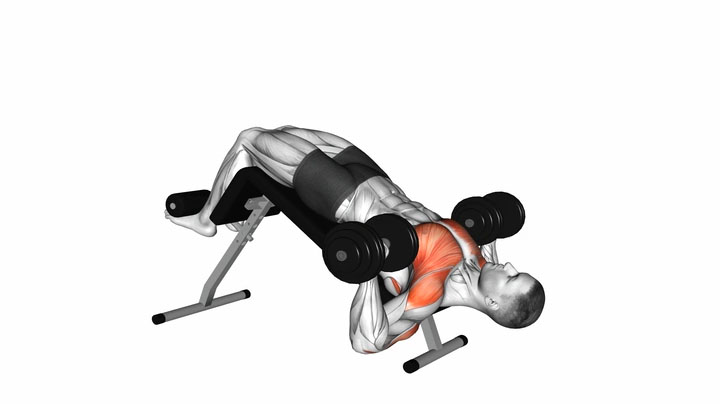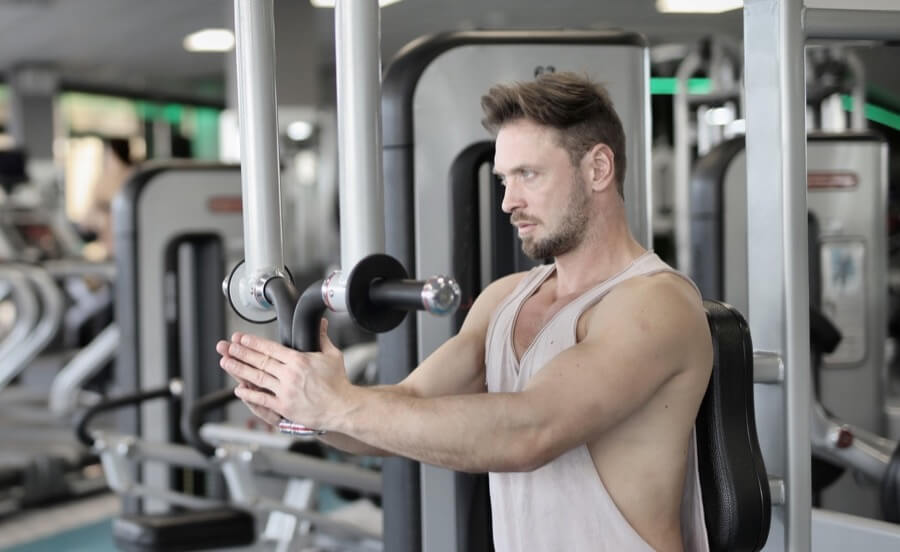Chest workouts are a favorite for many people. Walk into any gym today, and you’ll undoubtedly see at least a few people doing chest exercises – bench press, flys, push-ups, and more. You name it, and someone is probably doing it. Even so, many lifters struggle to develop a full and dominant chest, one that looks great from top to bottom. The ‘armor plate’ chest, if you will.
A common reason for this relates to the lack of lower chest training. Prevailing wisdom suggests to “bench press, and your chest will grow.” So, many people follow this advice, only to find themselves achieving lackluster results.
We have created this guide of exercises and a lower chest workout to help you achieve stronger lower chest muscles. Read on to find out exactly how you should tackle your lower chest training.
Skip to:
Best Lower Chest Exercises
Lower chest workout At-Gym or At-Home
Anatomy of the Chest
Your chest is a large muscle group located on the front side of your upper torso. Including two heads: the clavicular (upper portion) and the sternal (middle and lower region) (1). The clavicular head represents the small upper position of the chest. The sternal head makes up a much more significant percentage of the chest, as it includes the middle and lower parts.
There are many myths regarding our chest muscles, and one such is that we can’t emphasize different portions of the chest. But the truth is, we can because of fiber orientation (2). Our upper chest fiber composition runs downward; the mid-chest fibers run horizontally (straight across); the lower chest fibers run upward, almost opposite the upper chest. Keep track of the muscles you are working out with Hevy.
Contracting (shortening) the sternal head of the chest leads to transverse shoulder abduction. Think ‘chest flys’ here. And since lower chest fibers run upward, activities that work opposite to the orientation allow us to better target and develop the region. A good example here is the decline bench press. This exercise is an excellent example of strengthening the lower chest (4).

Hevy – Workout Tracker
Create your own chest workouts with Hevy, and track your progress.







Hevy – Workout Tracker
Create your own chest workouts with Hevy, and track your progress – for free.
Keep track of the muscles you are working out with Hevy.
The 8 Best Lower Chest Exercises You Can Do for Complete Pectoral Development
1. Chest Dip
Chest dips are one of the best bodyweight exercises you can do to emphasize and develop your lower chest (5). The overloading potential is excellent, and learning how to do these doesn’t take that much time.


Muscle groups: Chest (emphasizing the lower portion), Triceps, Shoulders (mainly the front head), Serratus Anterior, and Abs
Equipment: Dip Bar
- Get up on the dip bar and grab it evenly as your arms are straight and to your sides. The width of the bar should be slightly greater than shoulder level.
- Bring your chest out, engage your abs, squeeze your glutes, and flex your arms.
- Step off the dip bar platform while supporting your body with your arms. Tilt your body slightly to engage your chest better as you go down.
- Take a breath and begin to dip as you bend your elbows. Descend down as comfortably as you can – ideally until your elbows are at a 90-degree angle.
- Push through your chest and triceps to get back to the top, and exhale.
2. Decline Bench Press (Barbell)
Though many people disregard the decline press, the movement offers superior lower chest activation thanks to the angle (4). Besides other compound exercises, the overloading potential is excellent, making the decline press a great lower chest-builder.
Muscle groups: Chest, Triceps, Shoulders (mainly the front head), Serratus Anterior, and Abs
Equipment: Decline Bench, Barbell, and Weight Plates
- Before lying down, set the bench at a decline of 15 to 30 degrees. Lay onto the bench, secure your feet and slowly lie flat.
- Be careful not to bump your head on the barbell. Your forehead should be underneath the barbell.
- Grab the bar evenly with a grip you would use on the flat bench. For most, this is slightly wider than shoulder level.
- Bring your chest out, engage your core, and squeeze your glutes.
- Push through your elbows to remove the bar from the rack and carefully bring it forward until it hovers over your lower chest.
- Take a breath and begin to lower the barbell in a straight line without allowing your elbows to flare. The bar should come down to your lower chest.
- Press the bar in the same vertical line until your elbows straighten. Breathe out.
3. Decline Bench Press (Dumbbell)
Similar to the barbell version, this declined bench press movement is fantastic for emphasizing and developing your lower chest. An added benefit of letting you train both sides independently, helping prevent side-to-side muscle imbalances.


Muscle groups: Chest, Triceps, Shoulders (mainly the front head), Serratus Anterior, and Abs
Equipment: Decline Bench and Pair of Dumbbells
- Set the bench at a decline of 15 to 30 degrees. Grab the dumbbells you’ll be using and get on top of the bench.
- Secure your feet, keep your elbows bent, and have both dumbbells close to your torso.
- Engage your abs as you slowly lower your upper body to the bench. When you are nearly flat on the bench, bring the dumbbells out and keep your elbows tucked in; don’t flare them out.
- Set up by bringing your chest out, keeping your abs engaged, and squeezing your glutes. With both dumbbells to your sides and elbows in a good position, take a breath and press in a straight vertical line until your arms are straight.
- Lower both dumbbells straight down as comfortably as you can – ideally, as your elbows reach torso level.
- Exhale at the bottom and repeat.
You might have to find a spotter who can hand you at least one of the dumbbells as you start lifting more weight. You can also use the Hevy app to create and track all your workouts.







Hevy – Workout Tracker
Create your own chest workouts with Hevy, and track your progress.







Hevy – Workout Tracker
Create your own chest workouts with Hevy, and track your progress – for free.
4. High Cable Fly Crossover
The pulley’s angle will significantly determine chest activation, which is why we recommend the high cable fly for lower pec training. Like all the other movements we have reviewed today, the angle works opposite to the lower chest fibers’ orientation, resulting in superior activation.
Muscle groups: Chest (emphasizing the lower portion), Shoulders (mainly the front head), Serratus Anterior, and Biceps
Equipment: Adjustable Cable Crossover Machine
- Ensure to set the same amount of weight on both sides of the machine, grab both handles, and bring them close to your body.
- Take a couple of steps forward, stagger your stance, and position your arms to your sides.
- Keep a minor bend in your elbows and avoid flaring them out too much; keep them relatively tucked in.
- Bring your chest out, engage your abs, and squeeze your glutes. Take a breath and extend both arms forward until your hands meet and clutch your chest at the top.
- Slowly release both cables until your arms are to your sides and you feel a stretch in your chest as you exhale.
5. Chest Dip (Assisted)
The assisted chest dip is an excellent variation of the classic exercise that works well for beginners that do not have the strength to do dips without assistance.
Muscle groups: Chest, Shoulders (primarily the front head), Serratus Anterior, Triceps, and Core
Equipment: Assisted Dip Machine
- Begin by setting the pin on a low enough weight. Then stand or kneel on the platform (depending on the model), grab the dip bar evenly, and bring your chest out.
- With your arms straight, engage your abs, take a breath, and descend into a dip.
- Go down until your elbows reach a 90-degree angle and push back up to the starting position, exhaling at the top.
- If you’ve selected the correct resistance, you should feel moderate effort on the way down and up.
- Aim for between 8 and 12 repetitions.
6. Chest Dip (Weighted)
This exercise is an advanced dip variation and one that allows you to overload your chest with more weight as you get stronger (8). Attach weight plates with a special belt or hold a dumbbell between your feet, and you can increase the difficulty over time.


Muscle groups: Chest, Shoulders (primarily the front head), Serratus Anterior, Triceps, and Core
Equipment: Dip Bar, Weight Plates, Weight Belt, and Dumbbell
- Place the special weight belt on and attach a weight you feel is manageable. If this is your first time, begin with a 10-pound plate.
- Once the weight is secure, get on top of the dip bar and grab it evenly with both hands. The grip will be slightly wider than shoulder level, and your arms should be straight.
- Bring your chest back, engage your abs, squeeze your glutes, and step off the platform.
- As you support yourself on your arms, tilt your body forward a bit to emphasize your chest, take a breath, and dip.
- Descend to a 90-degree angle with your elbows and push up to the starting position. Exhale at the top.
If you’re going to use a dumbbell for extra resistance, position it near your feet and pinch it before starting the set. Alternatively, have a friend place the dumbbell between your feet.
7. Decline Chest Fly (Dumbbell)
The decline dumbbell fly is one of the few isolation exercises that greatly emphasize your lower chest. Adding this to your lower chest workout is a great way to accumulate volume and achieve more balanced pec development.
Muscle groups: Chest (emphasizing the middle and lower portions), Shoulders (mainly the front head), Serratus Anterior, and Biceps
Equipment: Decline Bench and Dumbbells
- Begin by setting the bench at a decline of 15 to 30 degrees. Grab both dumbbells, get on the bench, and secure your legs.
- With your elbows bent and dumbbells close to your body, carefully lie back. As you reach the bottom, extend your arms into position with the dumbbells directly over your chest.
- Bend your elbows slightly and keep them in that position for the entire set. Set up by bringing your chest out and digging your shoulder blades into the bench.
- Inhale and lower both dumbbells to your sides until you feel a prominent stretch in your chest.
- Bring both dumbbells to the starting position and tap them lightly as you exhale near the top.
8. Inclined Push Up
The incline push-up preferentially targets the mid and lower chest fibers because of your body position and the direction of pressing.


Muscle groups: Chest (emphasizing the middle and lower portions), shoulders (mainly the front head), and Triceps
Equipment: Plyo box, gym bench, chair, etc.
- Place your hands on the edge of a sturdy object (plyo box, gym bench, chair, etc.).
- Straighten your body as you would for a regular push-up.
- Bring your shoulders back and squeeze your glutes.
- Take a breath and lower yourself to the object you’re using, tapping your chest at the bottom position.
- Press yourself back to the top and fully extend your arms as you exhale.
2 Lower Chest Workouts: At Gym and At Home
Learning how to work out your lower chest is not complicated. Still, it would be best if you had some guidance to have the best lower chest workout.
Workout 1: Lower Chest Workout at the Gym
This first workout features the dip, one of the best bodyweight movements you can do to emphasize the lower chest (5). You would not have to worry that you will find a free bench. If you can do more than 15 bodyweight dips, consider attaching the weight to yourself to stay in the recommended repetition range.
- Bodyweight Chest Dips – 3-4 sets of 6-15 reps
- Decline Bench Press (Dumbbell) – 2-3 sets of 10-15 reps
- High Cable Fly Crossover – 2-3 sets of 12-20 reps
Click here to find and log this workout on the Hevy app.
Workout 2: Lower Chest Workout at Home
Who says we can only have effective workouts at the gym? The truth is, home workouts are a perfectly viable alternative, especially if you have no other choice (6). If you’re unable or uncomfortable training at your local gym, this workout is for you. It follows a similar structure to the ones we saw above, but you can do it at home with minimal equipment.
- Chair Chest Dips – 3-4 sets of 6-20 reps
- Incline Push-Ups – 3-4 sets of 6-30 reps
- High Resistance Band Crossover – 2-3 sets of 15-30 reps
Click here to find and log this workout on the Hevy app.


Before moving on, I’d first like to go over the importance of safety. Chair chest dips are a perfectly viable exercise, but make sure you use the same pair of chairs and make sure both are sturdy, balanced, and reliable. If you ever feel unstable or unsure, stop the set.
A great place to find information, reviews, and advice to create your home gym is Garage Gym Reviews. They test and review all kinds of gym equipment, which will make it easy for you to make a safe and fully functional at-home gym.
The 4 Critical Components of Effective Chest Training
Prior to wrapping up this guide, I’d like to spend a few more paragraphs on a few critical elements of good chest training:
- Good technique
- Proper exercise selection
- The mind-muscle connection
- Doing enough repetitions
1. Good technique
Excellent technique is vital because it allows you to engage the correct chest muscles and keep your joints safe. After all, the goal of training isn’t to hoist weights from point A to B but to use the right muscles and exhaust them thoroughly. So, always make sure to do each exercise with good form and feel the correct muscles working.
2. Proper exercise selection
Each exercise is a tool we can use to get fit, muscular, and strong. Many exercises serve similar functions, and you can achieve decent results without ever paying that much attention to the movements you do.
For example, you can build an impressive chest by bench pressing, so long as you push yourself and stay consistent. But if you’re looking to maximize your time in the gym, develop your chest muscles in a balanced way, and keep your training fun, you should pay attention to exercise selection. We’ve listed seven great movements for your lower chest, and we have a rich library of other exercises for every muscle group in your body.


3. The mind-muscle connection
Research shows that consciously trying to engage specific muscles allows for slightly better activation with lighter weights (9). So, it’s always good to feel the right muscles working, at least to some degree.
For instance, if your goal is to train and develop your lower chest, you need to feel the region work. If it doesn’t, this could be a sign that you need to find better exercises, improve your technique, or train with different loads.
4. Doing enough repetitions
Strength gains occur at higher intensities, but we need to build enough volume for muscle growth (6, 10). Repetition means doing enough repetitions on most sets to allow for a proper stimulus.
In a practical sense, we should do anywhere from 6 to 25 repetitions on most of the sets we do, depending on the exercise (8, 11). For instance, you can train more weight on compound exercises like the decline barbell press and do more repetitions on isolation movements like the high cable fly.
Conclusion
Building an impressive chest is more than simply bench pressing often. While a minimalistic approach can work, you need a balanced strategy to develop the three distinct areas. For most people, building up the middle and upper portion of the chest isn’t an issue. Regular pressing and some incline work will get them there. But building up the lower chest is a bit more complicated and requires the use of often-neglected training angles.
Most notably, this means you should include at least some decline work. This angle of attack allows you to emphasize the lower chest and overload it with heavier weights. Dips are also great for that because they can cause significant mechanical tension, spark growth, and fill up your pectorals evenly. It is also good to keep track of your workouts, keep your motivation up, and watch your progression.







Hevy – Workout Tracker
Create your own chest workouts with Hevy, and track your progress.







Hevy – Workout Tracker
Create your own chest workouts with Hevy, and track your progress – for free.
And the best part? Training the lower chest isn’t that complicated. So long as you choose the right exercises, focus on good technique, and establish a mind-muscle connection, you will grow the region.
Frequently Asked Questions
What is a good lower chest workout?
A good chest workout to target the lower portion is one where you get to emphasize the lower portion through various exercises and with different loads. These exercises will allow for a more balanced stimulus and enough mechanical tension and metabolic stress (11).
How long should I rest between sets?
Researchers find that more extended rest periods might benefit strength and muscle gain (12, 13). It would help if you rested for as long as you need to maintain consistent performance throughout your workout. For most sets, this would mean resting between 1.5 and three minutes.
Do I even have to worry about training my lower chest?
Yes, you should worry about training your lower chest. Just as you attack other muscle groups with various exercises and through different angles, your chest also responds well to a varied approach.
How often should I train my lower chest?
It depends on how much work you want to put in for your lower chest per week. But aiming for doing lower chest work twice per week should be enough to see significant gains.







